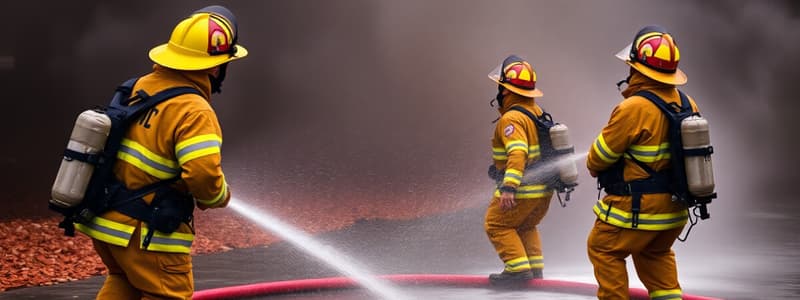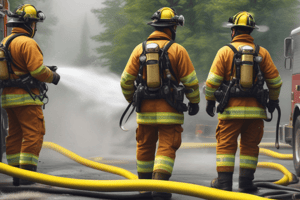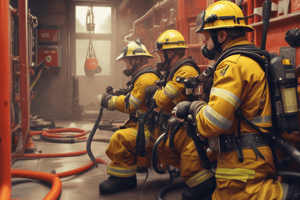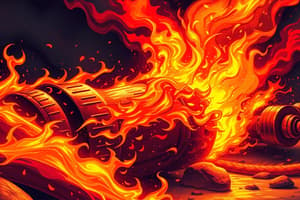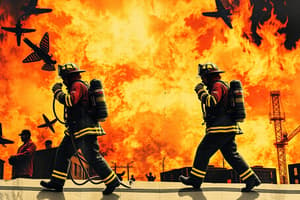Podcast
Questions and Answers
What is a key advantage of the triple fold hose load?
What is a key advantage of the triple fold hose load?
- Easier to manage on your shoulder
- Deploys quicker than modified minuteman loads (correct)
- More versatile around obstacles
- Can reach further distances
Which disadvantage is associated with the modified minuteman 50' bundle?
Which disadvantage is associated with the modified minuteman 50' bundle?
- May not reach the objective sufficiently (correct)
- Deploys quicker than the triple fold
- Can be difficult to manage on a shoulder
- Not as effective at splitting cars
What makes the modified minuteman 100' bundle easier to manage around obstacles?
What makes the modified minuteman 100' bundle easier to manage around obstacles?
- More of the hose is on the firefighter's shoulder (correct)
- It is taller than other loads
- It deploys quicker than other loads
- It has fewer moving parts
What is one disadvantage of the triple fold hose load?
What is one disadvantage of the triple fold hose load?
Why might firefighters prefer the modified minuteman loads over the triple fold in certain situations?
Why might firefighters prefer the modified minuteman loads over the triple fold in certain situations?
Why is it important for the nozzle to sit farther back than the midpoint coupling?
Why is it important for the nozzle to sit farther back than the midpoint coupling?
What is the purpose of placing a loop in the stack of hose?
What is the purpose of placing a loop in the stack of hose?
How much hose needs to be loaded for a 250' preconnect?
How much hose needs to be loaded for a 250' preconnect?
What should be done with the coupling at the tail of the bundle?
What should be done with the coupling at the tail of the bundle?
What position should the straps face when deploying the bundle?
What position should the straps face when deploying the bundle?
When building the pack, where should the straps be positioned?
When building the pack, where should the straps be positioned?
What does it indicate if the hose bed divider is set up for a single stack?
What does it indicate if the hose bed divider is set up for a single stack?
What is the recommended distance to walk when clearing the hose bed if the loop is placed 50’ in?
What is the recommended distance to walk when clearing the hose bed if the loop is placed 50’ in?
What is the purpose of placing a loop in the rear of the hose bundle at the midpoint?
What is the purpose of placing a loop in the rear of the hose bundle at the midpoint?
How should the coupling be positioned when loading the hose?
How should the coupling be positioned when loading the hose?
What should be done to ensure the coupling is correctly placed during loading?
What should be done to ensure the coupling is correctly placed during loading?
What is a characteristic of the midpoint loop when loading the second section of the hose?
What is a characteristic of the midpoint loop when loading the second section of the hose?
During hose loading, what is the first step that crew members should take?
During hose loading, what is the first step that crew members should take?
What should be used to mark the midpoint of the hose?
What should be used to mark the midpoint of the hose?
Why might the midpoint not fall exactly on the loop during loading?
Why might the midpoint not fall exactly on the loop during loading?
What is the final step after placing the second loop during hose loading?
What is the final step after placing the second loop during hose loading?
What is the advantage of deploying the working length in an 'Attack over Supply' orientation?
What is the advantage of deploying the working length in an 'Attack over Supply' orientation?
When is operating with a 1 ¾” line typically advantageous?
When is operating with a 1 ¾” line typically advantageous?
Why is it important for firefighters to ensure handlines are loaded properly?
Why is it important for firefighters to ensure handlines are loaded properly?
What must firefighters adjust in their approach when using larger diameter hoses?
What must firefighters adjust in their approach when using larger diameter hoses?
What is the target flow rate cited for effective operation with a smaller line?
What is the target flow rate cited for effective operation with a smaller line?
What is a key characteristic of working with larger handlines in a commercial environment?
What is a key characteristic of working with larger handlines in a commercial environment?
What should be avoided when using larger lines during deployment?
What should be avoided when using larger lines during deployment?
What is the impact of raising the first 50’ of hose off the ground?
What is the impact of raising the first 50’ of hose off the ground?
What should firefighters do when taking wider nozzle angles?
What should firefighters do when taking wider nozzle angles?
What is the recommended nozzle pattern in a large commercial space?
What is the recommended nozzle pattern in a large commercial space?
What is the primary goal when sweeping the nozzle across the ceiling?
What is the primary goal when sweeping the nozzle across the ceiling?
What needs to be ensured while attacking a fire with a hose team?
What needs to be ensured while attacking a fire with a hose team?
Why do fires often fail to go out?
Why do fires often fail to go out?
What should firefighters aim for to use water most efficiently?
What should firefighters aim for to use water most efficiently?
How do smoothbore nozzles help with fire suppression?
How do smoothbore nozzles help with fire suppression?
What is a critical aspect of using larger water lines in firefighting?
What is a critical aspect of using larger water lines in firefighting?
Flashcards are hidden until you start studying
Study Notes
Hose Loads
- There are three main hose loads.
- Triple Fold: Deploys quickly but not versatile around obstacles
- Modified Minuteman - 50' Bundle: Easy to manage on shoulder, can split cars, but may not reach objective and deploys slower
- Modified Minuteman - 100' Bundle: Versatile around obstacles, good for residential structures, easier to split cars, bundle may be difficult to manage on shoulder.
Handline Function
- 2" and 2 1/2" handlines are the largest in CFD's arsenal and should not be expected to be manipulated like 1 3/4" handlines.
- When attacking with a 1 3/4" line, firefighters are able to work quickly because the fire environment is usually compartmentalized and 160 GPM provides sufficient protection.
- Commercial fires require a more methodical approach due to the nature of potential fires, and firefighters should slow down and flow water early.
Attack Line Orientation
- Having the nozzle and coupling at the point of service is crucial for any deployment.
- "Attack over Supply" orientation raises 50' of hose off the ground, helping with advancement and reducing friction.
- Firefighters should attempt to deploy inline with respect to the advance whenever possible.
Nozzle Pattern
- In large commercial spaces, the ideal nozzle pattern is a sweeping motion at the ceiling level, rather than the typical O pattern.
- Start high and sweep left to right, cooling the ceiling above the area firefighters will potentially be occupying next, displacing ceiling tiles, exposing void space, and cooling the roof structure.
- Lower the stream angle incrementally with each sweep to win back the building.
- Ensure fire stays in front of firefighters.
Reach and Penetration
- The most efficient way to extinguish a fire is to get water on the material that is burning, not evaporate the water into steam.
- Large droplets from smoothbore nozzles travel farther through the thermal column and resist vaporization, providing a better chance of impacting the fuel-flame interface.
Studying That Suits You
Use AI to generate personalized quizzes and flashcards to suit your learning preferences.
